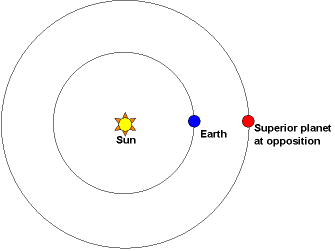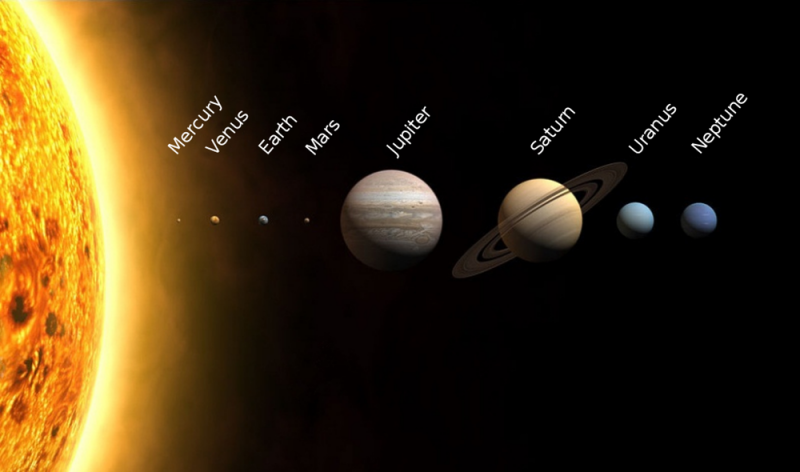
These next several mornings – May 11, 12, 13 and 14, 2020 – let the waning moon introduce you to three bright morning planets. Jupiter is by far the brightest of the threesome, beaming some seven times more brilliantly than either Saturn or Mars. Jupiter also outshines all the stars. You’ll have no trouble identifying Jupiter. Mars and Saturn are fainter, but – like Jupiter, and like the moon – follow the approximate path of the ecliptic (sun’s path) across our sky. Thus the three planets, and the moon, make a small, graceful arc across our predawn sky. Mars and Saturn are almost equally bright (Mars is a tad brighter), and there are other ways of distinguishing Saturn from Mars. First of all, Saturn shines in close vicinity to Jupiter, and these two worlds will remain close together on the sky’s dome for the rest of 2020. Find dazzling Jupiter first, and that nearby bright world will be the ringed planet Saturn any time this year. Remember … you need a telescope to see Saturn’s rings.
Now use Jupiter and Saturn as pointers, to find Mars. Look along the approximate path traveled by the sun and moon, in the direction toward the sunrise. Mars will be the next-brightest object along this path. Also, you can distinguish Mars from Saturn by color. Mars glowers red while Saturn appears golden. If you can’t tell the color difference with your eyes alone, try using binoculars.
By the way, there’s a dwarf planet, Pluto, up there, too. Pluto is some 1,000 times too faint to be viewed with the eye alone, however. Pluto and Jupiter are having a triple conjunction in 2020. Read more: Jupiter gives us Pluto in 2020

View at EarthSky Community Photos. | Frank Lu in Arlington, Texas caught this image of the 3 planets on May 4, 2020. He wrote: “Constellation Capricornus flanked by Mars on the left and Saturn and Jupiter to the right. Mars is rapidly moving further away.” The planets are bright and can be seen from inside most cities, but you need a relatively dark sky to see Capricornus. If you have one, note that Capricornus looks like an arrowhead. Thanks, Frank!
Right now, our planet Earth is heading around on the inside track in its smaller and faster orbit around the sun, so that the distance between us and the slower-moving planets – Jupiter, Saturn and Mars – is decreasing as we speak. These planets, in turn, are slowly but surely brightening in Earth’s sky day by day.
Mars, Jupiter and Saturn are superior planets (planets that orbit the sun outside of Earth’s orbit). Any superior planet is at its brightest in Earth’s sky whenever the Earth swings in between the sun and that superior planet. When that happens, the superior planet is said to be at opposition, because it’s opposite the sun in our sky (rising at sunset, highest up in the sky at midnight and setting at sunrise).

Opposition happens when Earth flies between an outer planet, like Mars, and the sun. This happens yearly for most of the outer planets (except Mars – which reaches opposition every other year). Illustration via Heavens Above.
Opposition is an extra special time to view planets in our sky. Not only is the planet at its brightest for the year for some weeks around then, but it’s up all night long, beaming from dusk until dawn. The brightness change of Jupiter and Saturn will be relatively subtle. On the other hand, the change in the brightness of Mars will be profound and dramatic in 2020. We explain why in this post about Mars and the moon.
Opposition dates in 2020:
Jupiter: July 14, 2020
Saturn: July 20, 2020
Mars: October 13, 2020
Note how closely in time Jupiter and Saturn reach opposition. That’s because, as mentioned above, they are near each other on our sky’s dome. Jupiter and Saturn will remain close companions all year long, and these twin beacons will be out first thing at dusk/nightfall, starting late July 2020.
Now note how much farther away in time Mars’ opposition will be. Mars doesn’t reach opposition until October 2020. That’s because – as a planet whose orbit lies just outside Earth’s orbit around the sun – Mars not only undergoes a dramatic brightness change at opposition, but, also, around the time of its opposition, we see it move rapidly in front of the stars.
Thus, in the coming weeks and months, you can watch as Mars makes a beeline in front of many constellations.

The planets of the solar system to scale by size (but not distance). In their order going outward from the sun: Mercury, Venus, Earth, Mars, Jupiter, Saturn, Uranus, and Neptune. To know the planetary distances in astronomical units, click on Heavens-Above: Solar system.
Bottom line: Before sunrise these next several mornings – May 11, 12, 13 and 14, 2020 – use the moon to locate the king planet Jupiter, the ringed planet Saturn, and the red planet Mars.
from EarthSky https://ift.tt/2zmuQhR

These next several mornings – May 11, 12, 13 and 14, 2020 – let the waning moon introduce you to three bright morning planets. Jupiter is by far the brightest of the threesome, beaming some seven times more brilliantly than either Saturn or Mars. Jupiter also outshines all the stars. You’ll have no trouble identifying Jupiter. Mars and Saturn are fainter, but – like Jupiter, and like the moon – follow the approximate path of the ecliptic (sun’s path) across our sky. Thus the three planets, and the moon, make a small, graceful arc across our predawn sky. Mars and Saturn are almost equally bright (Mars is a tad brighter), and there are other ways of distinguishing Saturn from Mars. First of all, Saturn shines in close vicinity to Jupiter, and these two worlds will remain close together on the sky’s dome for the rest of 2020. Find dazzling Jupiter first, and that nearby bright world will be the ringed planet Saturn any time this year. Remember … you need a telescope to see Saturn’s rings.
Now use Jupiter and Saturn as pointers, to find Mars. Look along the approximate path traveled by the sun and moon, in the direction toward the sunrise. Mars will be the next-brightest object along this path. Also, you can distinguish Mars from Saturn by color. Mars glowers red while Saturn appears golden. If you can’t tell the color difference with your eyes alone, try using binoculars.
By the way, there’s a dwarf planet, Pluto, up there, too. Pluto is some 1,000 times too faint to be viewed with the eye alone, however. Pluto and Jupiter are having a triple conjunction in 2020. Read more: Jupiter gives us Pluto in 2020

View at EarthSky Community Photos. | Frank Lu in Arlington, Texas caught this image of the 3 planets on May 4, 2020. He wrote: “Constellation Capricornus flanked by Mars on the left and Saturn and Jupiter to the right. Mars is rapidly moving further away.” The planets are bright and can be seen from inside most cities, but you need a relatively dark sky to see Capricornus. If you have one, note that Capricornus looks like an arrowhead. Thanks, Frank!
Right now, our planet Earth is heading around on the inside track in its smaller and faster orbit around the sun, so that the distance between us and the slower-moving planets – Jupiter, Saturn and Mars – is decreasing as we speak. These planets, in turn, are slowly but surely brightening in Earth’s sky day by day.
Mars, Jupiter and Saturn are superior planets (planets that orbit the sun outside of Earth’s orbit). Any superior planet is at its brightest in Earth’s sky whenever the Earth swings in between the sun and that superior planet. When that happens, the superior planet is said to be at opposition, because it’s opposite the sun in our sky (rising at sunset, highest up in the sky at midnight and setting at sunrise).

Opposition happens when Earth flies between an outer planet, like Mars, and the sun. This happens yearly for most of the outer planets (except Mars – which reaches opposition every other year). Illustration via Heavens Above.
Opposition is an extra special time to view planets in our sky. Not only is the planet at its brightest for the year for some weeks around then, but it’s up all night long, beaming from dusk until dawn. The brightness change of Jupiter and Saturn will be relatively subtle. On the other hand, the change in the brightness of Mars will be profound and dramatic in 2020. We explain why in this post about Mars and the moon.
Opposition dates in 2020:
Jupiter: July 14, 2020
Saturn: July 20, 2020
Mars: October 13, 2020
Note how closely in time Jupiter and Saturn reach opposition. That’s because, as mentioned above, they are near each other on our sky’s dome. Jupiter and Saturn will remain close companions all year long, and these twin beacons will be out first thing at dusk/nightfall, starting late July 2020.
Now note how much farther away in time Mars’ opposition will be. Mars doesn’t reach opposition until October 2020. That’s because – as a planet whose orbit lies just outside Earth’s orbit around the sun – Mars not only undergoes a dramatic brightness change at opposition, but, also, around the time of its opposition, we see it move rapidly in front of the stars.
Thus, in the coming weeks and months, you can watch as Mars makes a beeline in front of many constellations.

The planets of the solar system to scale by size (but not distance). In their order going outward from the sun: Mercury, Venus, Earth, Mars, Jupiter, Saturn, Uranus, and Neptune. To know the planetary distances in astronomical units, click on Heavens-Above: Solar system.
Bottom line: Before sunrise these next several mornings – May 11, 12, 13 and 14, 2020 – use the moon to locate the king planet Jupiter, the ringed planet Saturn, and the red planet Mars.
from EarthSky https://ift.tt/2zmuQhR

Aucun commentaire:
Enregistrer un commentaire